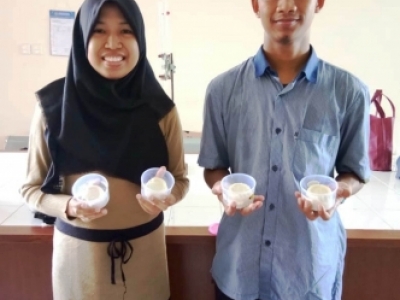
A group of students majoring in Chemistry Education of UNY consisting of Asmi Aris, Ilyas Gistiana and Hafiizhoh Hanafia, developed natural antibacterial soap made of Jatropha curcas Linn and cooking oil waste.
Jatropha curcas Linn contains flavonoids, saponins and tannins which have antibacterial properties. On the other hand, according to Asmi Aris, the use of cooking oil has become a basic requirement in food processing. "The high level of free fatty acids in oil can be processed into soap through a saponification process using an alkaline solution," Asmi said. The cooking oil waste is also quite abundant so that it can be used as an ingredient in making antibacterial soap.
Ilyas Gistiana explained that the processing of antibacterial soap goes through three stages, namely cleaning used cooking oil, making jatropha extraction and making antibacterial soap.
Hafiizhoh Hanafia explained that the soap produced is a type of solid soap intended for hand washing soap. The added jatropha curcas linn leaves extract provides anti-bacterial attribute that support personal hygiene and health. "The feasibility of soap is tested based on SNI 06-3532-1994 to determine the physical and chemical characteristics of soap so that it is safe to use," she explained.
This soap was tested by phytochemical, organoleptic, moisture content, acidity, free alkaline content, determination of the amount of foam and anti-bacterial. The results of the phytochemical test show that the sample changes color to a bluish green, this indicates the presence of phenolic compounds. The change in the color of the solution to red-orange indicates the presence of flavonoids. The emergence of a green-black color indicates the presence of tannin compounds. In the saponin test, it was observed that foam was formed and did not disappear for 10 minutes 1-10 cm, which indicated the presence of saponins. The anti-bacterial activity of the soap produced was tested on Staphylococus aureus and Escherichia coli by measuring the clear zone. The clear zone indicates that bacteria cannot grow in the zone which indicates an intervention from the activity of the soap being tested.
Based on these data, the soap of Jatropha leaves has anti-bacterial property which can inhibit the growth of Staphylococus aureus and Escherichia coli bacteria. The active compound in jatropha leaf extract can form an irreversible complex with steroids in the cell wall. The complex that is formed will result in damage to the cell membrane, so that bacteria cannot grow. (Dedy, Tj. Lak)
